The south coast of Cuba is strikingly rural, and life in the few small fishing villages that dot the coast is a step back in time considerably further than the 1960s when we lost touch with this country.
Yesterday we sailed 50 miles (or rather I should say motored because there wasn’t a breath of wind all day) from the small village of Chivirico to the next small village of Marea del Portillo. In the 50 mile stretch between these two harbors was a vast uninhabited shoreline where the Sierra Maestro range drops straight into the Caribbean Sea. We passed the tallest mountain in Cuba yesterday, 2000 meters above sea level. The more impressive statistic about this mountain range is that as we sailed just a few miles off shore the depths are at least equal to height of that one mountain. We were passing through waters that were from 5000 ft to 10,000 ft deep. This is a very dramatic coastline and an impressive mountain range.
Bob has written apost that beautifully describes what we are seeing in these small villages, and surprisingly agrees with most of what I would have written myself! We always find it a little surprising when we agree so completely on certain things, and this is one of those times.
We have only seen one or two boats when we are out sailing, and it’s no surprise that we end up in the same harbor every few days. There are so few harbors along this coast it is inevitable. The boats we’ve seen are all flying Norwegian flags. Last night we invited our neighbor Lars to dinner, after a long hot day with no wind we were all too tired to make much of an effort for dinner, and I think he was happy to have me doctor up some leftover rice with a bit of vege and egg and cheese. Lars has been living aboard his very pretty double ender, Luna, for more than 12 years. He has sailed around the world and has been in the Caribbean several times.
I enjoyed our evening with him in particular because he is the first person on this journey with whom I could talk a little about weaving and know that he would understand! Isn’t it interesting that after 4 years of sailing about this area I encounter a man who knows enough about weaving to listen to me talk about what I miss from home! One of my dearest friends is Norwegian, and there were noticeable about Lars that reminded me of her. I don’t know if that is because they both come from the same area of Norway, or if I was just bound to find them similar because I’ve been away from home so long and missing dear friends…. Lars compared the solitude of weaving to the solitude of single-handing his small boat. Also , the amount of preparation a weaver has to do before beginning to weave is similar to preparations for a sailing journey, and the concentration required for both while allowing our minds to enter a zen-like state while weaving or sailing. He was an enjoyable conversationalist for both Bob and me. This morning he left early to keep heading west while we have chosen to stay another day…maybe two.
In both Chivirico and Marea del Portillo there are government owned resorts just on the outskirts of the town. These resorts seem to attract Canadians. When we visited Hotel Brisas a couple of days ago for internet, we noticed all the people lounging in the courtyard were northerners (pale and fair haired) and then noticed that everyone was speaking English. The entire guest list on hand that day were Canadians, and all of them had been coming back to this beautiful secluded spot for numerous years. One couple, who’d been coming here for 25 years told us that the rate at the hotel was $750 for two weeks and included all meals and drinks and even the airfare. Unbelievable!
Pandora at anchor from about half way up the hill at Hotel Brisas.
On the one hand, while there are little window air conditioning units in each bungalow, there is rarely enough electricity to turn them on. That’s okay most of the time since there are ocean breezes to balance the discomfort from the heat. But the past week has had almost no wind, day after day. Still, the guests could float about in the pool or go down the 500-step stairway to the ocean and snorkel along the coral reefs, or just float in the water. The water is not quite cool enough to be refreshing at almost 90 degrees.
From our spot in the harbor we walked a bit beyond a mile to this hilltop resort, along a very steep, somewhat paved road with three switchbacks. Down in the village we asked one of the mule drawn cart drivers if he could take us up there, but he motioned that the mule could not make the steep climb. It was quite a trek. We were pleasantly surprised to learn that you can order as many things, including drinks, from the menu for one lunch fee. We had a number of cold drinks after that hot trek!
Water is also an issue everywhere in Cuba. Even in such a large city as Santiago de Cuba there are many days when the water system shuts down. As I understand it, it’s not they’ve run out of water but that the system has failed. The water system is from the 1950s and has had no updates or even repairs. The pipes are likely clogged with all kinds of debris, and the quality of the water is too poor for drinking. In the cities you can buy bottled water in large containers for drinking. In these little villages you have to boil your drinking water. I’m very glad that Bob and I are making water while we are out sailing. It is clean and clear and the color of deep indigo. Then our water goes through a number of filters before at last going into a Brita pitcher for drinking.
The sewars are in equally bad shape to the water system. The pipes have not been updated in the past 60 years either, so they also shut down often. You can never put toilet paper in the toilet. In many cases this means that there is no toilet in the bathroom, to prevent you from making that mistake! I knew before we left home that we would have to go ashore with our own. I was also warned that when the water system is shut down there would be no ability to flush toilets! And as I mentioned, this can go on for days—pretty horrible. For the most part we have only stayed ashore for the duration of time one can manage without a need for a toilet! I try not to drink so much water during the day when we are away from the boat, although that’s not easy in this heat!
So contrast these hurdles, which are admittedly rather large hurdles for me, against the dramatic landscape of mountains and pristine ocean, mostly unspoiled by any human habitation. It’s a rare and beautiful part of the world, but it does have it’s downside for a spoiled American like me who would prefer clean water and good toilets, and safe food!
A small house with tidy garden in Chivirico.
And where there people and animals living in clusters, the lifestyle is so simple. Everyone keeps chickens, and even pigs. They wander around everywhere, along with goats and dogs. The roosters crow all day and all night, and it reminds me of communities at home where you can call the local police to make someone get rid of their rooster for an offense like crowing all night. Yesterday we saw a very large pig being led down a sidewalk in Chivirico—now that’s something I’ve never seen. I had to wonder if that pig was on his way to a pig roast… Hopefully he’d just wandered a bit too far and was being led home…but at some point I imagine he’ll supply an awful lot of dinners for some family. I know he’s not just a pet. The goats seem to travel together and I wonder how anyone keeps track of whose goat is whose.
The men all seem to fish. They fish from their docks with hand lines…. They wade in the shallows throwing round nets. We’ve never seen them catch anything that we’d consider big enough to eat. The most interesting fishing vessel we’ve seen is an intertube. The fisherman floats around in it, using his hands to paddle himself about, and storing his catch in a milk crate that he has tied to the intertube.
No Cuban is permitted to own a boat longer than 20 feet. Hmmm…..is this to prevent them from going too far from shore? ….perhaps to another country entirely? Meanwhile, these small fishing boats all have inboard engines. I haven’t seen an outboard yet. I know the waters are full of fish here, so I think they get a good catch most days.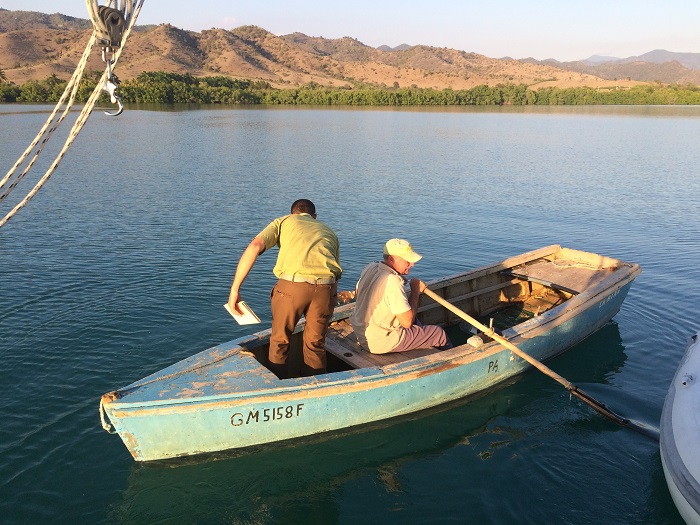
Along with big modern buses …alas, no AC…a very common mode of trasnsportation is mule or horse drawn cart.
As I write this I have to mention that Bob and came ashore toay in Marea del Portillo with a desperate need for internet. Our sailmail which is a sideband radio software that allows us to get our email when there is not internet has been slowly failing for over a week. As of three days ago it has failed. Bob has spent part of everyday for the past week trying to diagnose and fix it, but no luck. This is very dire to both of us since it is our only connection to our kids and to the facilities where both our mothers live. So internet was a high priority today. We had to get to a hotel just outside the village, a long hot walk. So we opted to take a horse drawn cart to get our internet! I don´t think I´ll ever experience that again! I´ll post a photo sometime….át the moment it´s still on the camera!
Lastly, a small comment about our most recent encounter with the Guarda Frontera: the official who visited us yesterday looked younger than our two sons, and he constantly referred to the last sheet in his notebook that was filled with writing, so I think he was very new to the job and was checking his to-do list. He asked a lot of questions that just seemed so trivial to us: how much water does our boat hold? How much gasoline does the can in the dinghy hold? We found this all fascinating as he carefully wrote down answers to all these questions. The Guarda Frontera have no boats of their own so they always have to flag down a fisherman with a skiff to bring them out to visiting cruising boats. In yesterday’s case the poor fisherman had no motor in his little skiff, so he had to row out to us on such a stifling day. We gave them both cold cokes, and I hope that helped.
Later, when we compared notes with Lars about the minutiae of questions asked by these officials, he a funny reply. He said that after all his experience with the Guarda Frontera you must simply go with the flow and answer their questions without giving it too much thought. They are not really looking for exact details anyway. They just need to fill out the forms. They have to write down something, it doesn’t much matter what. They will never check for accuracy. It’s all about filling out the form. He quoted what may be a well known saying in Cuba: “the people pretend to work, and the government pretends to pay.”

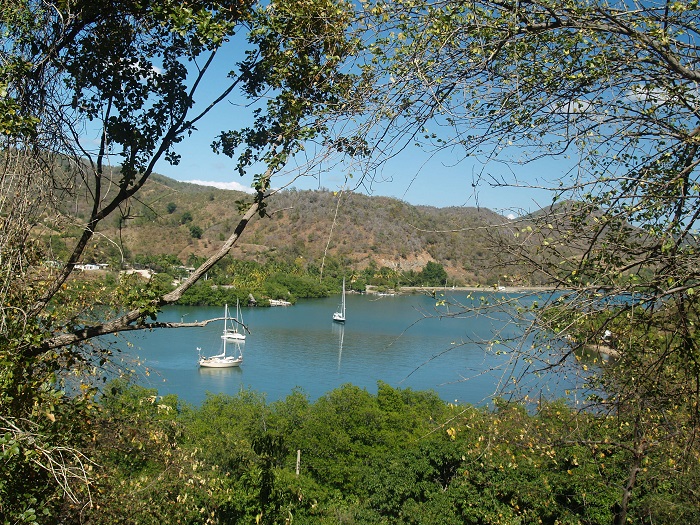
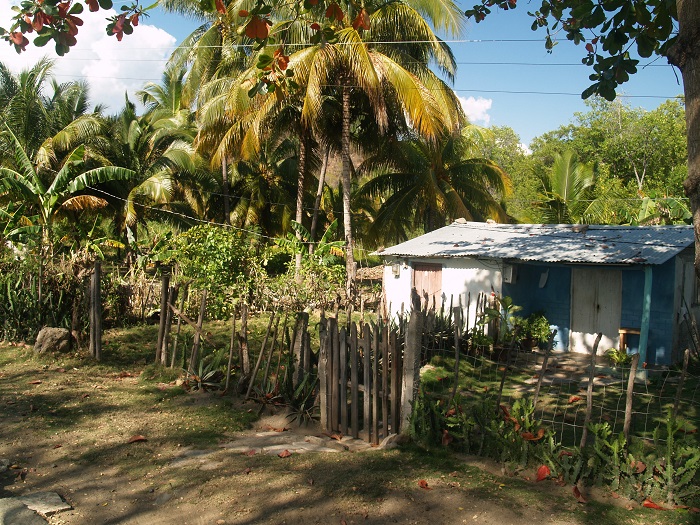
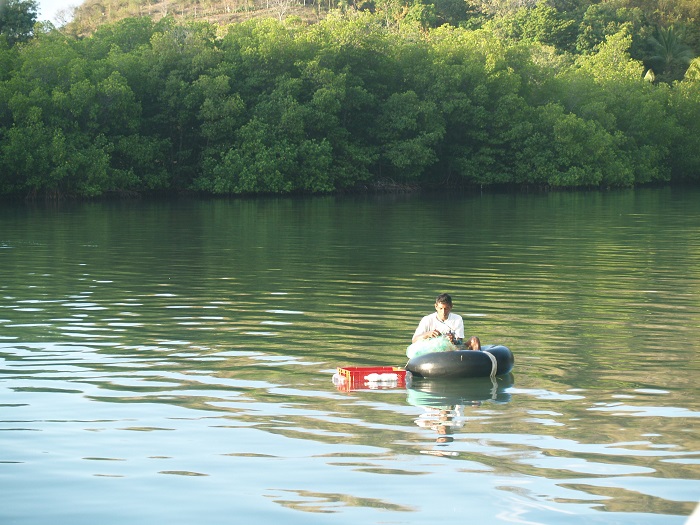
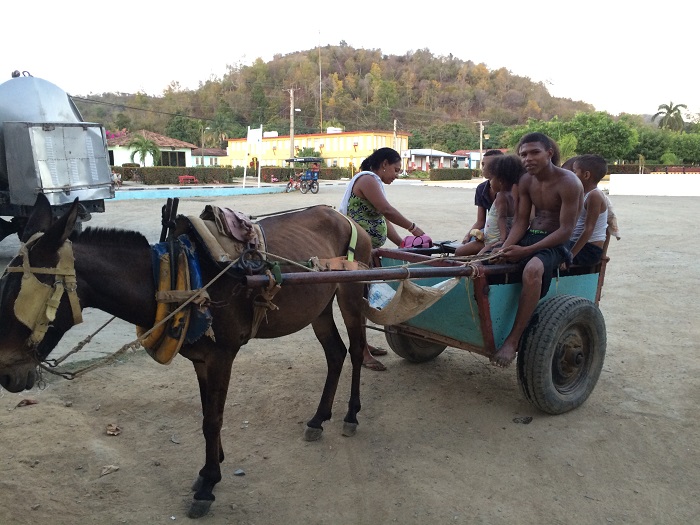
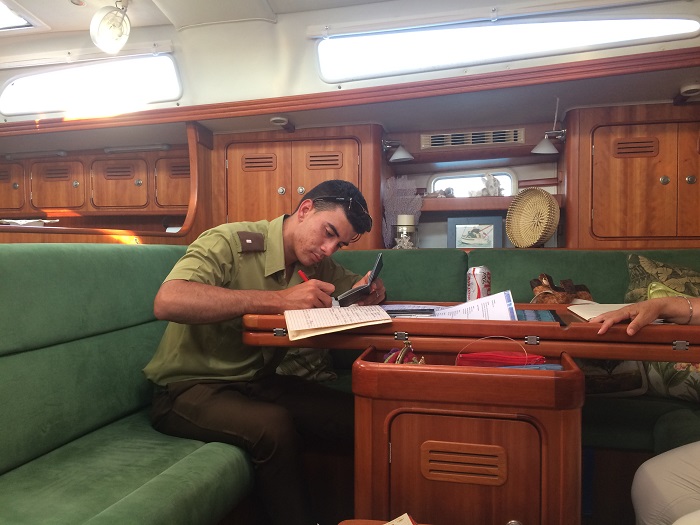


Pingback: One month from today on my way and memories of Cuba. | Sail Pandora